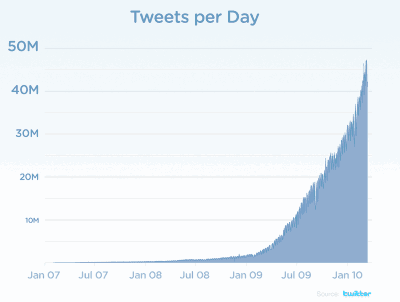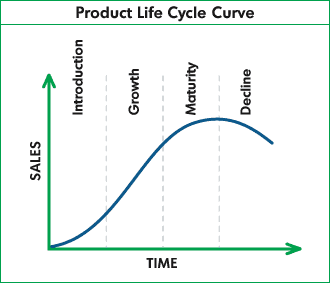Some amazing statistics have been released on the official Twitter blog touting 50 million tweets per day. Twitter has shown what entrepreneurs call hockey stick or exponential growth since January 2007 to January of 2010.

In January of 2007 Twitter was only seeing about 5,000 tweets per day and as of January 2010 it had risen to 50 million tweets per day. Kevin Weil, the writer of this post, notes that spam tweets were removed from these stats.
Twitter keeps track of quite a few key performance indicators such as TPD (Tweets per day) and also noted they keep track of TPS or tweets per second. On average twitter is steaming 600 tweets per second.
Another interesting stat is the concentration of users within the US. Just fewer than 36% of Twitter users come from the United States followed by India and Germany with 8% and 7% respectively, a pretty wide gap.
So what is next for Twitter?
This exponential growth is extremely encouraging but how long can it hold on and how long will the founders and management team want to hold onto the company?

Looking at the product life cycle above, Twitter would currently be moving from the introduction to growth phase. This is the current time period in the product life cycle that entrepreneurs sell their shares for large amounts of money based on the potential of the company.
When venture capitalists invest in a company they scrutinize the business plan, test the prototype, examine the amount of proposed rounds of funding and look for an exit strategy. The key here is the exit strategy. Eventually these investors want a return on their investment and can only live on hype so long. Many investors believe their return should come within 3-5 years, so their investors are probably chomping at the bit.
Eventually the growth will taper off and Twitter will not be able to sell their company or shares of their company at a ridiculously high valuation. If Twitters growth does slow and heads into the maturation stage it could still present the founding team with an opportunity to make a large amount of money but it will not be anything near what they could make it they sold their company now to someone like Google who can’t seem to get anything will social media right. (See social search, Wave and Buzz)
So the question to ask is what does the Twitter team want to do with their product? Change the way people communicate and share news? Or do they want an extremely large pay-day and get some cushy jobs on the management team but ultimately given up control of their product?
Guest author Justin Freid is the CEO and Founder of JustinFreidMedia.com, offering SEO and Paid Search advertising. Justin also runs an internet marketing forum to help others learn and implement SEO, PPC and Social Media. You can also write guest posts and share yout Twitter views.